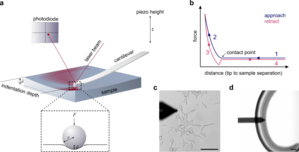Atomic Force Microscopy

Our lab uses indentation-type atomic force spectroscopy to determine the mechanical properties of hydrogels and various types of cells and tissues. The heart of the indentation setup is the cantilever –- a flexible spring leaf with a defined spring constant, which is usually decorated with a sharp tip or a spherical bead. An indentation measurement commences with the cantilever approaching the sample surface in a piezo-controlled manner. Upon establishing contact with the sample surface, the piezo is moved further until a preset force F or indentation depth δ is reached. Interactions between the indenter and the sample cause the cantilever to deflect. After a defined contact time the cantilever is retracted again. During this process, the cantilever deflection is recorded and plotted over the z-position of the piezo. This plot can then be converted into a force-distance curve, from which — after fitting to appropriate mechanical models — the apparent Young’s modulus E of the sample can be derived. In order to obtain information about viscoelastic properties of gels, cells and tissues, also time-dependent mechanical measurements can be conducted, e.g. by performing stress relaxation or creep compliance tests, or by microrheological measurements, where the cantilever is oscillated in contact with the sample and a phase shift (indicative of a viscoelastic response) between indentation and force response is measured.





